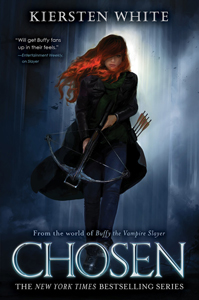It takes some getting used to, I admit, but eventually I got on a roll with Nina the Vampire Slayer in Kiersten White’s second Buffyverse novel, “Chosen” (January, hardcover). I should’ve braced myself for it after having read last year’s “Slayer,” but first-person present-tense writing is unusual enough that it’s still like getting a bucket of cold water to the face when you crack the book open.
In this sequel, Nina’s sister Artemis also gets point-of-view chapters in present tense via a third-person omniscient narrator focusing on her.
Finding Sanctuary
But mostly, “Chosen” is about Nina, who – after the events of “Slayer” – has turned their former Watchers castle in Ireland into Sanctuary, a place for Slayers to come and be safe. And I mean this book is extremely about Nina. We spend a ton of time in the teen’s head as she mourns the death of her boyfriend, Leo, and the fact that Artemis has left the castle to work for Sean, a man who kidnaps and sells demons.

“Chosen” (2020)
Author: Kiersten White
Series: “Buffy the Vampire Slayer: Nina the Vampire Slayer” No. 2
Setting: Between Seasons 8 and 9, Ireland
White’s prose is excellent, but Nina repeats the same sentiments a lot, even if never with the exact same inner monologue. But then about midway through the book, either Nina cuts back on her fretting, or the plot kicks into gear more, or I got more used to the young-adult writing style, or all three.
“Chosen” gets really good when characters from the TV show and Season 8 comics appear – even beyond Buffy and The First Slayer, who make cameos in Nina’s Slayer nightmares. White’s series is set between Seasons 8 and 9, during the time when magic is gone from the world but there are still Slayers and demons about. No new Slayers can be called, and vampires can’t sire new vamps; they would instead become zompires.
Even without the cameos – which I’ll discuss below the spoiler warning – I grew to know and like most of the large cast of “Chosen” more than I did in “Slayer.” The action is set in January 2007, but there’s definitely a Gen-Z/ “Chilling Adventures of Sabrina” point of view to the proceedings, including the fact that gay relationships (Artemis-Honora and Rhys-Cillian) are no big deal to anyone.
Even the Dark Horse “Buffy” comics were doing serious flag-waving about gay relationships within the last decade. White mentions people being “triggered” a couple times; I’m not a big fan of that – I guess it triggers me, ironically.
More White than ‘Buffy’ — at first
Those elements, along with the YA and first-person styles, make “Chosen,” like “Slayer” before it, more of a White book than a “Buffy” book — at first blush. It might turn off some readers, and I was in danger of being in the turned-off group, but ultimately I love this book.

(Spoilers follow.)
While the writing style is different, the themes are oh-so-“Buffy.” Actually, the new-to-“Buffy” writing style makes old themes fresh again. Artemis’ desire to gain enough power to save the world is reminiscent of Angel’s goal in the Season 8 comics.
But I like it more here because, one, her scheme makes more sense, and two, we see it from the schemer’s point of view, rather than being left to wonder who Twilight is, then having to reassemble the pieces once we know it’s Angel.
Nina frets a lot in “Chosen” about situations where she must choose either a loved one or the world, and how she’s a failure if she’s unable to choose the world. (Hey, I just realized the title has multiple meanings; cool.) Ultimately, this is her journey toward the lesson Buffy learns in Season 6: that family is important too.
Melding this novel more tightly into the Buffyverse are the cameos. Oz is delivering a trio of Slayers to Sanctuary, including Chao-Ahn (from Season 7). In “Slayer,” Nina spent a lot of time hating Buffy because her dad, Merrick, was killed while training Buffy.
Chao-Ahn provides critique of Buffy
That was a little shallow, but Chao-Ahn provides a meatier critique of Buffy. The Chinese Slayer reflects on how she was saved by Giles (no complaints from her there) but then thrown into the big battle against The First without being given a choice.
White does her best work when she analyzes commonly held beliefs from the “Buffy” mythos and puts a new spin on them. Joss Whedon’s storytelling emphasizes the wrongness of the ancient Watchers putting power into one (usually poor) girl at a time, someone who never asked for it, and whom the Watchers can control. White, via Nina, presents the counterargument that through most of history, a lower-class girl is perfectly positioned to roam the dark streets with the vampires and not be noticed.
White doesn’t show us many “normal” people in “Chosen,” but she does briefly examine the question of what society thinks of vampires and the supernatural. In my head, I had thought society had adjusted to the idea by the start of Season 8 — even if society, particularly the military, doesn’t like the sudden bevy of Slayers. But White pulls back on that notion a bit. A demon convention is disguised as a makeup effects convention for the sake of the public.
And within that convention is a booth for Harmony and her reality TV show, “Harmony Bites.” (Harmony doesn’t appear in this book, but Clem does, and he makes his first chronological admission that he is in love with his boss.) One of the human convention-goers asks if Harmony is really a vampire. So I guess after Season 8, the supernatural is more widely acknowledged in human society, but that’s not the same as being completely acknowledged.
Decent mystery
The mystery writing is pretty strong here, and it’s one area – along with the castle setting – where I get slight “Harry Potter” vibes even though White’s style is much different from J.K. Rowling’s. A lot of “Chosen” is about trust, and right along with Nina, we wonder who in the castle can be trusted and who can’t. This is a particularly big issue for her, since her life has been defined by people being dishonest with her (often for her own good, but still).
The mystery of “Who can we trust?” is also the source of my biggest quibbles in this otherwise great read. Structurally, Imogen works fine as the mole within CTU – I mean, the castle – but I don’t totally grasp her motivations. Also, White regularly reminds us that Nina hates Honora, but doesn’t remind us of why; I know it’s in the first book, but many readers will have gone a year since reading “Slayer.”
All told, though, I love “Chosen” in a similar way to how I loved Timothy Zahn’s post-“Return of the Jedi” “Thrawn Trilogy” in the early 1990s. The “Buffy” comics on the main timeline are done, and how or whether a future TV spinoff will fit into the timeline is unclear at the moment.
White’s books are a treasure that has become rare: new chapters in the grand story we love, very focused on Nina yet respectful of the Buffyverse mythology that has been so expertly constructed dating back to 1997.

